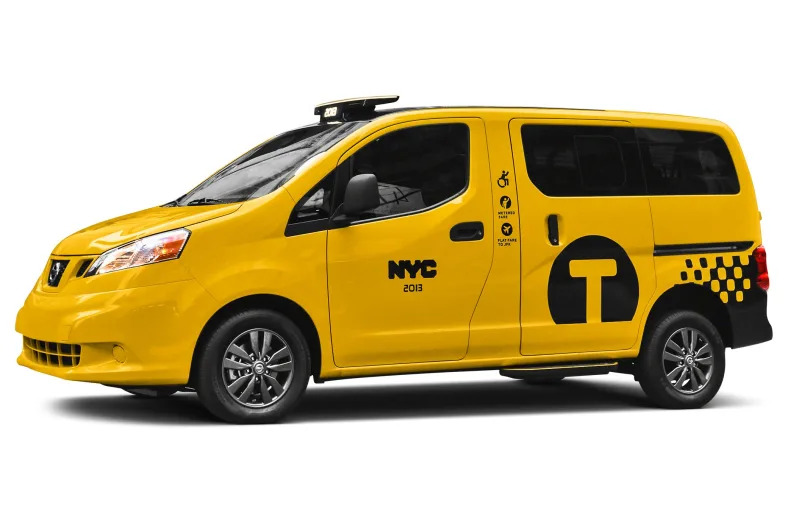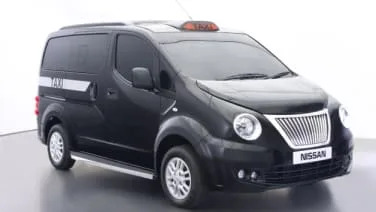2014 Nissan NV200 Taxi
"You're a long way from home!" When I signed up to drive a pre-production version of the Nissan NV200 Taxi, I expected to have a higher-than-normal level of interaction with the public at large. However, while I was hoping for unsuspecting Ann Arborites to perhaps hail me down, or maybe even get a hop-in when stopped at an intersection, I didn't really think I'd be hassled in parking lots so much. And yet, almost as if all of the Dad-Joke energy in the universe was drawn to my tall, yellow ride, seemingly everywhere I parked I heard some iteration of the phrase above. Har har, guys. So, my week as a taxi driver didn't go as I'd planned – not a single fare was earned. But I did get a good sense for why and how Nissan is making another significant push into the workaday world of commercial vehicles. Driving Notes My NV200 test vehicle wore a 2013 model year designation but was technically specified as a 2014 taxi model with New York City livery. Though Nissan NV200 taxis are popping up, or about to, in markets all over the country, my test car was liveried for New York City where the model is now in service. It was NYC taxis and other fleet cars that honed the NV into the vehicle you see here; cabbies and passengers helped tailor its content to fit real needs. From a passenger perspective, this means the luxury of room, if not luxurious materials. The rear bench seat has acres of legroom to go with just enough width to fit three abreast. There's also room for a fourth passenger in the front, though that sorry sucker will miss out on amenities like a really big rear entertainment screen (sadly non-functional in my demo car) and easily accessible 12-volt and USB charging ports. There are even independent climate controls for passengers that get too hot or cold. As I mentioned, materials and surfaces tend towards durable and not stylish. Nissan tells me that the simulated leather seating surfaces are easy to clean, which I can believe, and also anti-microbial, which seems like a great idea. One extra effort against cold and flu season. The driver's seat, meanwhile, has a breathable cloth surface on the seat bottom and back that is also a little bit grippy, for what it's worth. The seat itself is pretty flat and soft, perhaps designed to wear well, but it won't be the most supportive chair for long stints behind the wheel. The driver also faces one of the most austere dashboards and instrument clusters I've seen in some time – though that's hardly unexpected for a work vehicle. The 5.8-inch infotainment display is unspectacular in view of regular passenger cars, but is kind of a high-end feature in this segment. Everything else, from the hard-surfaced steering wheel to the flinty gray and black plastics and the basic switchgear all seems aimed at long life and cost reduction. Handling is …
Full Review
"You're a long way from home!" When I signed up to drive a pre-production version of the Nissan NV200 Taxi, I expected to have a higher-than-normal level of interaction with the public at large. However, while I was hoping for unsuspecting Ann Arborites to perhaps hail me down, or maybe even get a hop-in when stopped at an intersection, I didn't really think I'd be hassled in parking lots so much. And yet, almost as if all of the Dad-Joke energy in the universe was drawn to my tall, yellow ride, seemingly everywhere I parked I heard some iteration of the phrase above. Har har, guys. So, my week as a taxi driver didn't go as I'd planned – not a single fare was earned. But I did get a good sense for why and how Nissan is making another significant push into the workaday world of commercial vehicles. Driving Notes My NV200 test vehicle wore a 2013 model year designation but was technically specified as a 2014 taxi model with New York City livery. Though Nissan NV200 taxis are popping up, or about to, in markets all over the country, my test car was liveried for New York City where the model is now in service. It was NYC taxis and other fleet cars that honed the NV into the vehicle you see here; cabbies and passengers helped tailor its content to fit real needs. From a passenger perspective, this means the luxury of room, if not luxurious materials. The rear bench seat has acres of legroom to go with just enough width to fit three abreast. There's also room for a fourth passenger in the front, though that sorry sucker will miss out on amenities like a really big rear entertainment screen (sadly non-functional in my demo car) and easily accessible 12-volt and USB charging ports. There are even independent climate controls for passengers that get too hot or cold. As I mentioned, materials and surfaces tend towards durable and not stylish. Nissan tells me that the simulated leather seating surfaces are easy to clean, which I can believe, and also anti-microbial, which seems like a great idea. One extra effort against cold and flu season. The driver's seat, meanwhile, has a breathable cloth surface on the seat bottom and back that is also a little bit grippy, for what it's worth. The seat itself is pretty flat and soft, perhaps designed to wear well, but it won't be the most supportive chair for long stints behind the wheel. The driver also faces one of the most austere dashboards and instrument clusters I've seen in some time – though that's hardly unexpected for a work vehicle. The 5.8-inch infotainment display is unspectacular in view of regular passenger cars, but is kind of a high-end feature in this segment. Everything else, from the hard-surfaced steering wheel to the flinty gray and black plastics and the basic switchgear all seems aimed at long life and cost reduction. Handling is …
Hide Full Review
Hide Full Review
Retail Price
$29,700 - $29,700
MSRP / Window Sticker Price
| Engine | 2.0L I-4 |
| MPG | Up to 24 city / 25 highway |
| Seating | 5 Passengers |
| Transmission | Xtronic 2-spd CVT w/OD |
| Power | 131 @ 5200 rpm |
| Drivetrain | front-wheel |
| Curb Weight | 3,255 lbs |
Smart Buy Program is powered by 





